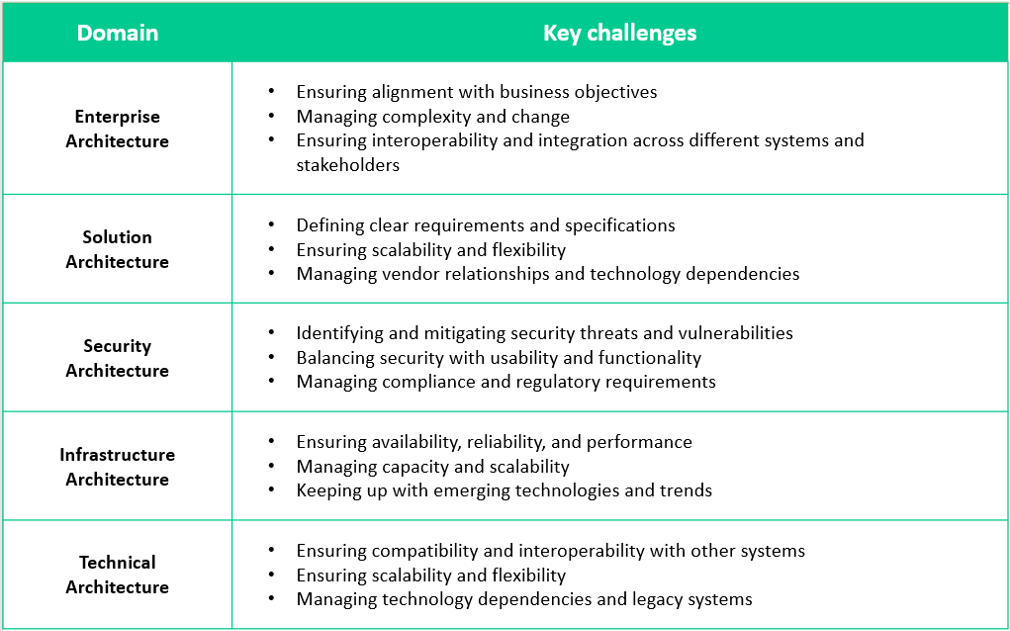In a world where technology is a vital component of every business, it’s more important than ever to make sure that your IT architecture can keep up with your company’s growth and goals.
IT architecture assessment allows you to identify opportunities for improvement, eliminate redundancies, streamline IT systems and processes, reduce costs, and improve overall performance.
In this article, we’ll guide you through the key aspects of an IT architecture assessment, and show you how it can help you align your technology infrastructure with your business strategy, cut costs, and boost your overall performance.
What is IT Architecture?
IT architecture refers to the way that technology infrastructure, systems, applications, and data are organized and integrated to support business objectives.
IT architecture includes several domains, including enterprise architecture, solution architecture, security architecture, infrastructure architecture, and technical architecture.
Enterprise architecture refers to the framework for organizing IT systems and processes to align with business objectives.
Solution architecture is the design of specific systems or applications.
Security architecture is about the protection of data and systems from cyber threats.
Infrastructure architecture refers to the design of networks, servers, and storage systems.
Technical architecture is the design of software and hardware components.

Why does your business need an IT architecture assessment?
There are many benefits to conducting an IT architecture assessment. Here are some of the key ones:
Align technology with business strategy: An IT architecture assessment helps organizations ensure that their technology infrastructure supports their business objectives. By evaluating their technology investment portfolio, businesses can identify gaps and take steps to fill them.
Reduce costs: An IT architecture assessment can help identify opportunities for consolidation, standardization, and optimization. This can lead to the elimination of redundant technology and reduced maintenance costs.
Improve performance: By assessing end-user performance and other performance management activities, businesses can identify areas for improvement and optimize systems and processes for better efficiency.
Manage risk: An IT architecture assessment can help identify security vulnerabilities and address them before they become a threat. This can help businesses protect themselves against cyber threats.
Conducting an IT architecture assessment can help businesses align their technology infrastructure with their business strategy, reduce costs, improve performance, and manage risk.
4-step guide for conducting an IT architecture assessment
An IT architecture assessment involves several steps that are designed to help businesses evaluate their technology infrastructure and identify areas for improvement. Here’s a breakdown of the steps involved:
Inventory IT assets and systems: This step involves identifying all IT systems and assets, including hardware, software, applications, and data. By doing this, you can understand what systems and applications are currently in place and how they are interconnected.
Assess current architecture: The next step is to assess the current architecture of IT systems. This step helps identify strengths and weaknesses in the current architecture and identifies areas for improvement.
Identify gaps and develop recommendations: After assessing the current architecture, the next step is to identify gaps and develop recommendations for improvement. This step involves defining the business objectives that the IT architecture should support, identifying gaps between the current architecture and the desired state, and developing recommendations for closing those gaps.
Develop an implementation plan: The last step is to develop an implementation plan for the recommendations. This step involves developing a roadmap for implementing the recommendations, including timelines, budgets, and resource requirements.
Additional tips for conducting an IT architecture assessment
When conducting an IT architecture assessment, it’s essential to use an enterprise architecture assessment framework to guide your process. The most popular frameworks include TOGAF, Zachman, and FEAF. These frameworks provide a structured approach to conducting an IT architecture assessment, making it easier to identify gaps and develop recommendations.
Here are some additional tips for conducting an IT architecture assessment:
Define the scope of the assessment before you begin. This will help you ensure that you are focusing on the most critical areas.
Involve end-users in the assessment to ensure that their needs are considered.
Use a variety of assessment methods, including interviews, surveys, and system testing, to gather comprehensive data.
Prioritize recommendations based on their impact on business objectives and the effort required for implementation.
Regularly communicate progress and findings to key stakeholders to ensure buy-in and support for implementation.
The role of consultants in IT architecture assessment
An IT architecture assessment is a complex and time-consuming process that requires expertise in several domains, including business architecture, functional architecture, technology architecture, and application architecture. That’s why many businesses choose to hire consultants to help with the process. Here are some of the benefits of hiring a consultant:
Consultants bring a wealth of expertise and experience to the IT architecture assessment process.
They can help businesses define their business objectives and identify the IT architecture requirements that support those objectives.
They can also help businesses identify gaps in their current architecture and develop recommendations for improvement.
When selecting a consultant for an IT architecture assessment, it’s essential to choose one with experience in the specific domains relevant to your business. Here are some roles to consider hiring:
Enterprise architect: an expert in enterprise architecture who can help you align your IT systems with your business strategy.
Business architect: an expert in business architecture who can help you define your business objectives and identify the IT architecture requirements that support those objectives.
Technical architect: an expert in technical architecture who can help you evaluate your current IT infrastructure and identify areas for improvement.
Technology architect: an expert in technology architecture who can help you develop recommendations for improving your IT systems and processes.
Look for consultants with experience in enterprise architecture programs, coordinated agency strategic planning, and investment portfolios. By hiring the right consultant, you can ensure that your IT architecture assessment is thorough, effective, and tailored to your specific business needs.
Conclusion
To sum it up, IT architecture assessment is an important process that helps businesses align their technology infrastructure with their business goals, cut costs, improve performance, and manage risk. T
he process involves evaluating IT systems, identifying areas for improvement, and developing a roadmap for implementation. Hiring a consultant with relevant expertise and experience can help ensure a thorough and effective assessment.
By following these guidelines, businesses can optimize their IT infrastructure to meet their needs and achieve their objectives.




